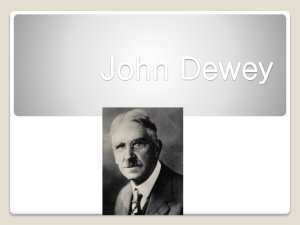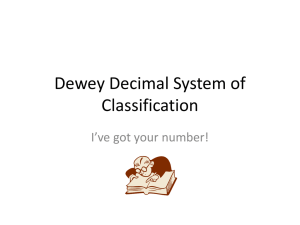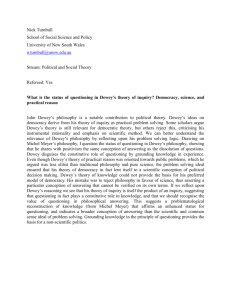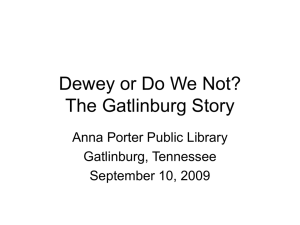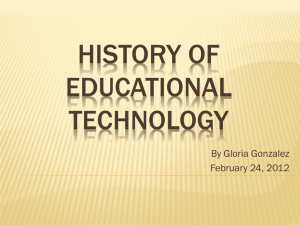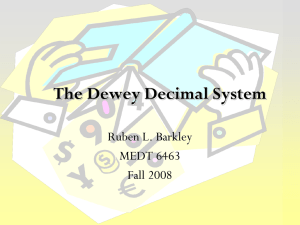EESD13 Paper
advertisement
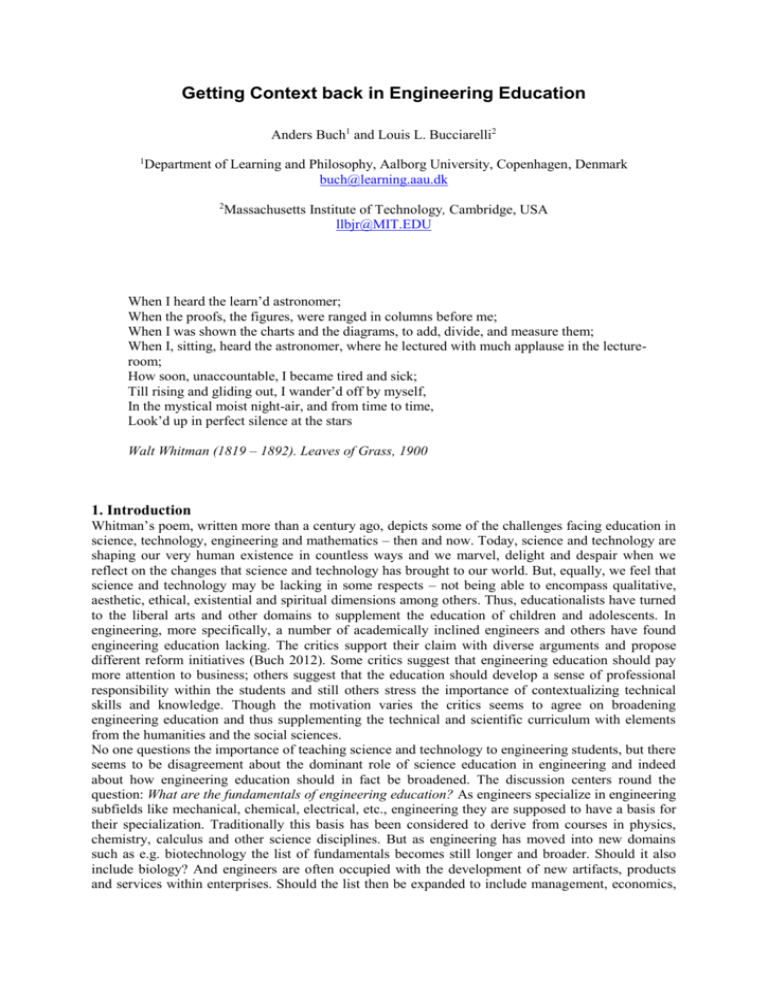
Getting Context back in Engineering Education Anders Buch1 and Louis L. Bucciarelli2 1 Department of Learning and Philosophy, Aalborg University, Copenhagen, Denmark buch@learning.aau.dk 2 Massachusetts Institute of Technology, Cambridge, USA llbjr@MIT.EDU When I heard the learn’d astronomer; When the proofs, the figures, were ranged in columns before me; When I was shown the charts and the diagrams, to add, divide, and measure them; When I, sitting, heard the astronomer, where he lectured with much applause in the lectureroom; How soon, unaccountable, I became tired and sick; Till rising and gliding out, I wander’d off by myself, In the mystical moist night-air, and from time to time, Look’d up in perfect silence at the stars Walt Whitman (1819 – 1892). Leaves of Grass, 1900 1. Introduction Whitman’s poem, written more than a century ago, depicts some of the challenges facing education in science, technology, engineering and mathematics – then and now. Today, science and technology are shaping our very human existence in countless ways and we marvel, delight and despair when we reflect on the changes that science and technology has brought to our world. But, equally, we feel that science and technology may be lacking in some respects – not being able to encompass qualitative, aesthetic, ethical, existential and spiritual dimensions among others. Thus, educationalists have turned to the liberal arts and other domains to supplement the education of children and adolescents. In engineering, more specifically, a number of academically inclined engineers and others have found engineering education lacking. The critics support their claim with diverse arguments and propose different reform initiatives (Buch 2012). Some critics suggest that engineering education should pay more attention to business; others suggest that the education should develop a sense of professional responsibility within the students and still others stress the importance of contextualizing technical skills and knowledge. Though the motivation varies the critics seems to agree on broadening engineering education and thus supplementing the technical and scientific curriculum with elements from the humanities and the social sciences. No one questions the importance of teaching science and technology to engineering students, but there seems to be disagreement about the dominant role of science education in engineering and indeed about how engineering education should in fact be broadened. The discussion centers round the question: What are the fundamentals of engineering education? As engineers specialize in engineering subfields like mechanical, chemical, electrical, etc., engineering they are supposed to have a basis for their specialization. Traditionally this basis has been considered to derive from courses in physics, chemistry, calculus and other science disciplines. But as engineering has moved into new domains such as e.g. biotechnology the list of fundamentals becomes still longer and broader. Should it also include biology? And engineers are often occupied with the development of new artifacts, products and services within enterprises. Should the list then be expanded to include management, economics, marketing, etc.? In fact it is quite difficult to delimit the field of engineering and thus equally difficult to answer the question of what the fundamentals of engineer education should be. Discussions about engineering education have also to a large extent focused on another fundamental question: how should engineering be taught to students? Whereas the first question focus on curriculum, this second questions address issues of didactics. If we can agree on a curriculum in engineering education, how can engineering then be taught most effectively? Various methods have been suggested, implemented and tested. At our own institutions – MIT and Aalborg University – two models have been influential: Professor Ed Crawley, of MIT’s Department of Aeronautics and Astronautics in collaboration with Swedish universities have developed the CDIO-model (Conceive – Design – Implement – Operate) and Aalborg University have developed the PBL-model (Problem Based Learning). Both models have spread to other universities and have been implemented in engineering programs around the world. Although we recognize the importance of discussions about curriculum and didactics we will, however, approach engineering education from another vantage point – in order for us to return to these important issues from another angle and with another perspective. John Amos Comenius contrasted didactics – the science of teaching – to mathetics – the science of learning – in his Spicliegium didactium published in 1680. He argued that we need to have a clear vision of how we learn before we can develop our teaching methods. We will follow Comenius and ague along similar lines that we need to understand how we learn in order to address questions about curriculum and didactics in engineering education. Thus we address a third question, namely: how is engineering learned? – or in more general terms ´How do we learn (engineering)? in order to return to the other two questions: What are the fundamentals of engineering education? How should engineering be taught? In this paper we will thus focus on learning. It might be objected that a broader discussion on learning will defocus the discussion on how engineering education can in fact become more adequate. We tend to disagree. Discussions about reform in engineering education have mainly centered on issues of curriculum and didactics but these discussions rarely address fundamental questions about the nature and character of knowledge and learning. This neglect has led the discussions down the wrong track and failed to critique implicit and inadequate conceptions of knowledge and learning. Our discussion will draw upon John Dewey’s philosophy of human experience and inquiry as a resource that can remedy the neglect.i 2. Traditional ways of teaching engineering – decontextualizing In order to get our argument started it is necessary briefly to review traditional ways of teaching engineering. Here we will see how engineering knowledge is traditionally conceived. Prerequisites to enrolling in the engineering education are the courses in the calculus, physics, chemistry, now biology. These are seen as fundamental. And they are in the way that they provide the student with the vocabulary, the tools, the concepts and principles upon which the engineering sciences base their development of more concepts and principles and methods - enabling students to solve the problems assigned in mechanics, thermodynamics, electronics, etc. The engineering sciences in turn are held as fundamental to practice, e.g., engineering design and to further study and research at the graduate level. The purpose of assignments and exercises within engineering education, whether mechanical, electrical, civil, chemical, etc., is to convey a well established body of instrumental, disciplinary knowledge from faculty to the student. The abilities stressed are problem solving within the discipline’s paradigm using its concepts and principles alone. Here, for example, is an excerpt from a well-know textbook in engineering mechanics. “The main objective of a basic mechanics course should be to develop in the engineering student the ability to analyze a given problem in a simple and logical manner and to apply to its solution a few fundamental and well-understood principles.” (Beer et al. 2006, xiii) The mechanics problem is given - not to be formulated by the student; it demands a simple and logical analysis - not a conjectural, inferential thinking up and about; and is to be solved using a few fundamental and well-understood principles - not by trying several, alternative, perhaps conflicting, approaches and perspectives. The work-life of an engineering student, hence graduate, from this perspective is neat, well posed, deductive and principled. Solving well posed, single-answer, problems is the dominant learning experience of the undergraduate. It is a solitary activity; engaged in competition with one’s peers. It is an essential activity in engineering practice, but it is not all. Solving problems is a necessary part of engineering work - work within a bounded discipline, e.g, structures, electronics, etc., with its own particular resources including concepts, principles, heuristics, metaphors, methods, codes, standards, supplier catalogues, instruments, techniques of fabrication, and more. It is necessary work but it does not suffice. For example, in design, many with whom engineers must work may not see the world in the way they do. The (over)emphasis on solving well-posed, single-answer, problems with its reductionist, deterministic ideology works against taking the social and constitutive features of engineering seriously. Instrumental rationality is evident in the ways a ‘problem’ is described to be ‘solved’ and what is deemed a legitimate ‘solution’. The exercise of instrumental rationality requires abstraction and simplification. This is key to methods for problem solving in all fields of engineering. “[Abstraction requires] Simplification of a complex problem by breaking it down into manageable components. Specifically modeling in quantitative terms critical aspects of the physical and human world, and necessarily simplifying or eliminating [our emphasis] less important elements for the sake of problem analysis and design...”( MIT, Engineering Council for Undergraduate Education, 2005, 4) For a problem to be treated as an engineering problem it must be expressed in quantitative terms. Only factors, aspects and feature of the ‘real’ world that can be construed as measurable and quantified matter. Numerical measures of inputs, outputs, parameters, variables, behavior and performance, costs and benefits are the essential ingredients of a problem. One might wonder what criteria are used in eliminating, (or deforming), more qualitative elements for the sake of problem analysis and design. Is it perhaps the case that only those ‘elements’ that can be quantified are considered at all? Anything that can’t be measured is, ipso facto, irrelevant, not of interest or significance? This way of thinking is evident in the desire to make engineering design into an engineering science. And it’s this way of thinking that leads us to write and speak of knowledge as if it were some kind of material stuff or well-defined entity; e.g., We gain knowledge, store it away somewhere in our head; transfer it to our students; students claim that my course is ‘like taking a drink from a fire hydrant’. Our research contributes to the body of knowledge and we measure this in large part by the number of our publications. We know more now than before. The ‘knowledge as stuff’ metaphor leads us astray in our case, down the path of curriculum reform that constrains our discussion to what material we must cover, what we must leave out, what we should keep in – what the ‘fundamentals’ of engineering are. We refuse to go that way. Instrumental rationality is essential to engineering but it fails when taken too far, when presumed a basis for all of our thoughts, for dealing with events and features, phenomena and people, beliefs and values, that can not, ought not, be reduced to quantitative measure. Scott D.N. Cook and John Seely Brown (1999) have called this dominant position ‘the epistemology of possession’: knowledge being something that is well-defined, compartmentalized, mental, valuefree, something that individuals can either possess or lack and something that individuals can instrumentally put to use – regardless of context.ii This epistemology is flawed in two important respects. It fails to recognize that knowledge is always produced in specific settings where individuals interact with their concrete environment and community in a process of learning – it fails to recognize the importance of context in the process of learning. Secondly, it fails to recognize what is going on in a process of learning. We will draw upon the philosophy of John Dewey to elicit how context matters in the course of experiencing the world and how the process of learning unfolds. 3. Experience – contextualizing knowledge John Dewey was a strong critic of both empiricism and rationalism in the philosophical tradition. Empiricism and rationalism have both profoundly affected our conceptions of knowledge. But knowledge, Dewey claimed, cannot be adequately understood as either accumulated sensory impressions of individuals or ideas structured by a priori categories. Instead, it is necessary to understand the process and structure of the acquisition of experience. He departed from both empiricism and rationalism by rejecting the epistemological approach to the understanding of the production and acquisition of knowledge. Instead he gave an ontological account of human experience in naturalistic terms (Dewey 1948). He saw humans as biological organisms situated in and constantly interacting with the environment in the process of life. Biological evolution is not just a process of passive adaptation to an unchangeable environment: through our interactions we – and the environment – are both transformed. Dewey in his later writings (Dewey & Bentley 1991) actually preferred the term ‘transaction’ to ‘interaction’ because the former stress the fact that both man and environment are transformed in the interaction. “In the first place, the interaction of organism and environment, resulting in some adaptation which secures utilization of the latter, is the primary fact, the basic category. Knowledge is relegated to a derived position, secondary in origin, even if its importance, when once it is established, is overshadowing. Knowledge is not something separate and self-sufficing, but is involved in the process by which life is sustained and evolved. The senses lose their place as gateways of knowing to take their rightful place as stimuli to action.” (Dewey 1948, 67) Experience thus occurs in the course of action when our doings are interrupted. Experience is thus not a cognitive state, but “a clue in behavior” that can alter our habits and challenge us in an act of inquiry. It is important to note, that Dewey not only disentangles experience from the mentalistic connotations layered upon the term by empiricism, but he also demonstrates how experience is inextricably linked with context. It is not possible to experience out of context: an experience is always situated in time and in relation to a specific environment. Likewise, experience is not an isolated phenomenon – it is always linked to and builds on previous experiences and it has consequences for succeeding experiences. The demonstration of the continuity of experience is a fundamental cornerstone in Dewey’s contextualism. Another important element is related to the social mediation of experience. It is not the case that humans face the environment alone. The upbringing and education of humans is mediated by social meanings and categories that shape experience: “Things come to him clothed in language, not in physical nakedness, and this garb of communication make him a sharer in the beliefs of those about him” (Dewey 1948, 92). Our social categories, perspectives and interests thus pervasively mediate the line of experiences. The continuity and mediated character of experience implies that experience does not evolve in a mechanical and automatic way. In Dewey’s thinking experience is fundamentally historical in the sense that it has a narrative structure that raises particular events above the otherwise continuous flow of experienced moments in time. Dewey’s concept of experience is thus different from an experience in the common sense meaning of the term. Humans actively group experiences of moments that stand out from the rest and thereby form ‘consummatory’ experiences that structure and forms prior and subsequent experiences. The highlighting of particular significant moments in the stream of experiences is guided by our selective interests and contributes to the establishment of a background for the acquisition of further experiences. The organism – that is the human – is thus shaping and reshaping a context of interpretation in encountering and interacting with the world. Humans are not solitary being though, but fundamentally social creatures. The social mediation of experiences afforded by communication among humans transforms this context from a personal level to a collective sphere – which Dewey in his late writings labels ‘Culture’. In an unfinished revision of Experience and Nature Dewey writes: “The name ‘culture’ in its anthropological…sense designates the vast range of things experienced in an indefinite variety of ways. It possesses as a name just that body of substantial references which ‘experience’ as a name has lost.” (Dewey 2008, 363) Culture, in Dewey’s naturalistic sense, can thus be seen as the collective formation of our selective interests that shapes experience. Culture thus provides a context for our engagement with the environment. 4. Inquiry – the method of learning For Dewey knowledge acquisition and learning forms a mode of experiencing the world – and a very important mode. Organisms (humans) are involved in interactions with the environment and forms habits when the interaction is successful, i.e. when we are successful in dealing with and solving the problems we encounter. Sometimes, however, our habits do not suffice. The environment may have changed or we may be confronted with new phenomena and aspects of the environment. When this happens an opportunity for learning appears. Dewey preferred the terms ‘pattern of inquiry’ or ‘reflective thought and learning’ to signify the process that takes place in a situation where an organism is confronted with a problem (Dewey 2005). For Dewey ‘reflective thinking’ (and learning) is synonymous with ‘the scientific method’. Reflective thinking is a fundamental human approach of ‘active, persistent and careful’ investigation of beliefs and presuppositions in the light of the evidence that can support them and consequences that can spring from them. Inquiry is not a passive ‘contemplative’ reflection of formal modes of inferences from premises but an active engagement with the environment through experiments and tests. A characteristic of reflective thinking is the ability and willingness to refrain from jumping to conclusions and suspend judgment until sufficient evidence has appeared through examination and experiment. It is important to notice that Dewey’s equation between ‘inquiry’, ‘reflective thought and learning’ and ‘the scientific method’ does not give special priority to the methods most commonly used within the natural sciences – as opposed to the humanities or the social sciences. For Dewey the methods of the natural sciences are a subset of a more general and encompassing scientific method that is also at play in a cogent investigation of human and social affairs. The scientific method is thus a method that has led to the establishment of the sciences as bodies of knowledge – not the other way around. Reflective thinking and learning is a fundamental logical mode of inference founded in or biological existence (Dewey 1938). The method consists of five subsequent and related steps. The first step of the method is unfolding when an organism encounters a problem that blocks ongoing activates and reviles the inadequacy of the previous habits. In this situation humans are confronted with uncertainty and hesitation: the course of actions are interrupted. The second stage forces the individual to reflect on the location and character of the problem, thus trying to develop a definition of the problem in order to direct inquiry towards a solution of the problem. Thirdly, investigations and research into the problem must be conducted in order to establish evidence that can contribute to the solution of the problem. Fourthly, hypotheses are constructed and entertained. It is considered if the hypotheses suggest actions that potentially could lead to the solution of the problem, and the consequences implied by the hypotheses are considered. Lastly, the preferred hypotheses are selected and tested. A successful hypothesis will solve the problem – an unsuccessful will not. If this line of inquiry does not lead to solve the problem it must be reiterated, additional evidence must be collected and new hypotheses must be tested. ‘Knowledge’ is not a predominant concept in Dewey’s vocabulary. In fact he hesitated to use the concept because it easily leads to a-contextual and reified understandings of what is in fact a deeply contextual, contingent and dynamic process of coming to know (something). He preferred to describe the processes and situations in which we ‘think’, ‘reason’ and ‘learn’. Thus, Dewey, like Comenius, makes the argument, that we must understand the process of learning before we engage with questions about curriculum and didactics. Let us, therefore, turn to learning in engineering practice. 5. Learning in engineering practice It is easy to conclude that thought and practice within engineering, is mundane, done mechanically (looking up in tables, deciphering numbers arranged in columns, etc. as Whitman’s poem depicts...), routine or uninteresting. That’s the case for some tasks but not true in general. Quite the contrary: The challenges engineers face are never so neatly defined as problems to be solved (they first must be constructed), nor bounded so narrowly (defining interfaces requires more than a look-up table), nor devoid of opportunity for creativity (even in the smallest item) as the general public might presume. Engineers derive great pleasure and satisfaction from getting things to work right in accord with their conjectured solutions, their proposals, their designs. Finding an elegant solution to a problem, or going from ideas, words on paper, a statement of specifications, to a device that actually does what the boss or a client says it should do is quite an amazing achievement - and it is sensed that way. For there is no rulebook for doing such. Engineering work is immensely satisfying, albeit constrained and instrumental, quantitative and material. The narrowness of the domain, the instrumental nature of engineering work, frees the engineer from social concerns. Working uncontaminated by human foibles, varying opinion, subjective judgment - or this is the way it seems - one can dream of reinventing and saving the world, through the miracle of modern technology - oblivious to what goes on in the world. This fascination with technology in and of itself alone is characteristic of the exciting part of engineering work. And it is what sustains the energy and engagement of faculty in their teaching of undergraduate as well as graduate students. Here lie the roots of the value system fundamental to engineering education. But the system is deficient. It is deficient because it ignores context - the context of practice, the context of use, the context of the individual psyche and the context that our culture provides - barely acknowledged in the teaching of engineering. We rarely explore or show how social and political interests contribute in important ways to the forms of technologies we produce. We assume that engineering knowledge and know-how is universally accessible and understood by all in the same way - free of cultural variety or individual expression. With blinders on, what is seen is only the ‘hard’ stuff; what is discussed in earnest is limited to how to get from a well-posed problem statement to the unique solution, from a list of functional requirements in design to specifications of the product. It is a value system that glorifies the material to the extent that the system will not allow any serious discussion of values and visions other than those co-opted within itself. The way we structure our curriculum and teach our subjects conspire to instill in the student the idea that engineering work is value-free. Engineering work as instrumental problemsolving might be perceived to be so, but that is but one part of engineering competence. While teaching the ‘fundamentals’ of science and mathematics and the engineering sciences remains necessary, we must do so in more authentic contexts, showing how other than quantifiable constraints, costs, and benefits contribute in important ways to the forms of technologies we produce. We ought not as faculty imply as we do, that solving single answer problems or finding optimum designs alone, uncontaminated by the legitimate interests of others who see the world in other ways than we, is what engineers do all of the time. The fundamental problem and barrier to broadening then is the instrumental focus of our traditional curriculum, the reified conception of the ‘content’ of engineering knowledge. Teaching engineering as value-free, or what is much the same thing, teaching as though technological innovation in itself is always good and ignoring the complexities of cultural context - including who sets the ends - severely constrains opportunities for curriculum reform. The almost entire attention to means and methods to solve problems is selling students short, is doctrinaire, stifles questioning, creativity, reflection and debate, can be hazardous to society and borders on the irresponsible. 6. Conclusion The premise of our argument is that engineering education should be broadened in the sense that technical skills and knowledge should be contextualized. The technical curriculum of engineering education should be substantiated, supported, supplemented and critiqued by including historical, social, philosophical and ethical reflections of scientific and technological results and procedures. There are many reasons that support this premise, but we do not pretended to cover them all here. For example, we have not considered the benefits to students, industry or society of broadening curriculum or the effectiveness of adjusting didactics in engineering education by considering contextualizing teaching methods. Instead we have chosen to reflect on engineering education from the perspective of learning. Going back to John Dewey’s theory of experiential learning it becomes clear that the possibility of human experience presupposes context. As biological beings our organisms are in a continual process of interaction with the environment –not only to adapt, but also in order to transform the environment. In this process of transactions we experience. One experience building upon the previous and conditioning to succeeding. The continuity of experience entails that knowledge – the ‘product’ of experiences – cannot be compartmentalized into technical knowledge and ‘the rest’. Technical knowledge is intrinsically interwoven with other types of knowledges in our stream of experiences. Furthermore, as we interact with our fellow human beings in social relations, our experiences are mediated. Through social interaction humans transforms their individual experiences from a personal level to a collective sphere – context becomes culture. Dewey thus shows us that context and culture matters: it is a fundamental prerequisite in experiencing and interacting with our environment. To delimit historical, social and cultural phenomena from the curriculum in engineering education decontextualizes technical knowledge and dramatically confines the room for experiencing and interacting with the environment. Secondly, Dewey helps us understand that learning is better understood as a process of inquiry in relation to problems or disturbances in our flow of experiences than as acquisition of knowledge. Inquiry is in fact what the scientific method is all about. The scientific method is thus a method that has led to the establishment of the sciences as bodies of knowledge – not the other way around. This insight from Dewey ought to direct us away from the obsessive focus on what should be included and what should be excluded from engineering curriculum. This line of reasoning puts the cart before the horse. Instead, we ought to focus on installing opportunities for learning in engineering education. This will start by ‘interrupting’ experience and identifying problems to be solved. This is where learning starts and this is where engineering education should start. The ‘tricky’ part has to do with how this can be done – it has to do with didactics. The didactics of problem based learning (PBL) provides some cues, but we must be cautious not to equate working with problems with the process of inquiry. Dewey warns us: “Qualification of a situation as problematic does not, however, carry inquiry far. It is but an initial step in institution of a problem. A problem is not a task to be performed which a person puts upon himself or that is placed upon him by others – like a so called arithmetical “problem” in school work. (…) to set up a problem that does not grow out of an actual situation is to start on a course of dead work, nonetheless dead because the work is “busy work”. Problems that are self-set are mere excuses for seeming to do something intellectual, something that has the semblance but not the substance of scientific activity.” (Dewey 1938, 108) To set the process of inquiry in motion problems must be founded in real life – the historical, social and cultural elements in the situation must be brought out, investigated and critically examined – alongside the technical elements. To provide conditions for ‘problematic situations’ to appear in education is hard work – it requires close attention to the prerequisites of students, their interests and the ‘situation’ of teaching. All of this means more work for faculty and, no doubt, less time for research. How then to justify this effort? One way is to portray the development of tasks for students to engage as an opportunity for research in itself. The construction of these learning events, if they are to attend to the social/political contexts of engineering work, would require the collaboration of faculty from different disciplines. Admittedly, it is a challenge for faculty to engage in teaching more than “problems that are self-set” in their own discipline, none the less in collaboration with faculty from other disciplines, most of whom would not see the world in the same way. But a case may be made that the preparation for, and actual interaction with students in the inquiry and reflective modes Dewey prescribes can be seen as a kind of research – a research project as demanding as the specialized kinds of research that place such demands on faculty time. Furthermore the idea that classroom learning should “grow out of an actual situation” implies that the learning experiences we construct for (and with) our students will have a freshness about them each time they are initiated – a freshness like at the start of a new research project. Each time such tasks would be taught, it would be different – even if taught by the same faculty team. While commonly agreed upon "fundamentals" would hold center stage, there might be different applications of mathematical methods, different foci for reflection, depending upon the interests and competencies of faculty as well as students. Teaching in this way then becomes research but a form of research intimately connected with the preparation of students for reflective, professional practice. Finally, teaching engineering also requires close attention to the actual practice of engineering activities – be it in design practice, in the laboratory or wherever engineers are solving problems. We have gestured at some of these practices and advocated that engineering education should take its point of departure in authentic engineering situations where problems emerge. These situations are mostly complex in nature – comprised by technical, organizational, social, political, etc. elements and the students will need to acquire knowledge about the problem situation in order to frame and solve the problem. In engineering education the technical part is the ‘text’ and the historical, social, political, etc. elements are the ‘con-text’. In principle this could have been the other way around, but we recognize that engineering education must give priority to solutions that foregrounds material and ‘practical’ aspects. On the other hand we must emphasize that the instrumental and technical approach to problem solving must be balanced – context has to be considered. References Beer, F. P., Johnston, E. R. Jr., & DeWolf, J. T. (2006): Mechanics of Materials, McGraw-Hill, 4th ed. Bucciarelli, Louis (2003): Engineering Philosophy, Delft University Press Bucciarelli, Louis (2012): Bachelor of Arts in Engineering – The Full Proposal, http://dspace.mit.edu/handle/1721.1/71008 Buch, Anders (2012): Governing Engineering, in Steen Hyldgaard Christensen et al.: Engineering, Development and Philosophy: American, Chinese and European Perspectives (Philosophy of Engineering and Technology), Springer Cook, Scott D.N. & Brown, John Seely (1999): Bridging Epistemologies: The Generative Dance Between Organizational Knowledge and Organizational Knowing, Organization Science, vol. 10, no. 4, pp. 381 – 400 Dewey John (1938): Logic: The Theory of Inquiry, Henry Holt and Company Dewey, John (1948): Reconstructions in Philosophy, Beacon Press Dewey, John (2005): How We Think, Barnes and Noble Dewey, John (2008): Experience and Nature, in The Later Works of John Dewey, Vol. 1, ed. J.A. Boyston, Southern Illinois University Press Dewey, John & Bentley, Arthur (1991): Knowing and the known, in The Later Works of John Dewey 16, ed. J.A.Boydston. p. 1-294, Southern Illinois University Press Engineering Council for Undergraduate Education (2005): From Useful Abstractions to Useful Designs Thoughts on the Foundations of the Engineering Method, Part I, Draft, 7 May This paper draws on and includes sections from Louis Bucciarelli’s Bachelor of Arts in Engineering – the Full Proposal. ii The critique of this epistemology is elaborated in Bucciarelli 2003, p. 43 ff. i


